 Eastern Mojave Vegetation
Eastern Mojave Vegetation
Tom Schweich
 Eastern Mojave Vegetation
Eastern Mojave Vegetation
| Wild Horse Canyon Road - Mojave National Preserve |
|
Tom Schweich |

Topics in this Article: Road Log |
This file describes Wild Horse Canyon Road, from its north end on Black Canyon Road near Mid Hills Campground, to its south end also on Black Canyon Road near Hole-in-the-Wall Campground. | ||||
|
Literature Cited:
Other articles:
|
Road LogJunction: Black Canyon Road,, north to Cedar Canyon, or south through Black Canyon to Hole-in-the-Wall. | ||||
|
Other articles:
|
This panorama, taken June 27, 2005, after the Hackberry Complex Fire of June 22-25, 2005, shows that much of Round Valley burned as well as a good portion of Pinto Mountain. | ||||
|
Other articles:
Locations:
Pinto Mountain.
Round Valley.
|
| ||||
|
Other articles:
Locations:
Mid Hills Campground.
|
|||||
|
Other articles:
Locations:
Mid Hills Campground.
|
Mid Hills Campground
| ||||
|
Other articles:
|
Large knob of granite in the Mid Hills. This one had Golden Eagles nesting in a crevice near the top. | ||||
|
Other articles:
|
|||||
 Scene along Wild Horse Canyon Road near Mid Hills campground. Scene along Wild Horse Canyon Road near Mid Hills campground.
|
Scene along the Mid Hills ridge near Mid Hills campground. Large rounded outcrops of granite are visible through the Singleleaf Pinyons (Pinus monophylla). In the left foreground is the yellowish green of Green Ephedra (Ephedra viridis), and in the right foreground is the dark green foliage of Waxy Bitterbrush (Purshia tridentata var. glandulosa). | ||||
|
Locations: Silver Lead Spring. |
Silver Lead SpringYou can park here and walk down to Silver Lead Spring. It's about 1.5 km, and has a short steep section. The former mine tunnel provides perennial water for wildlife. | ||||
|
Other articles:
|
North out of Macedonia Canyon, Wild Horse Canyon Road climbs to Silver Lead Spring and the Mid Hills Campground. | ||||
|
Other articles:
|
South from Silver Lead Spring, Wild Horse Canyon Road descends into the head of Macedonia Canyon. | ||||
|
Other articles:
|
General view of vegetation along the Mid Hills ridgeline between Macedonia Canyon and Silver Lead Spring. A few Joshua trees (Yucca brevifolia) grow on the ridgeline and a little to the southwest, but this is the southwestern limit of Joshua trees in the Mid Hills. Columbia Mountain, namesake of the U.S.G.S. quadrangle, can be seen behind the pinyon (Pinus monophylla) on the ridgeline. | ||||
| Other species common at this location are Utah Juniper (Juniperus osteosperma), Buckhorn Cholla (Opuntia acanthocarpa), California Buckwheat (Eriogonum fasciculatum var. polifolium), Blackbrush (Coleogyne ramosissima), and Bitterbrush (Purshia tridentata var. glandulosa). | |||||
|
Other articles:
|
We saw this snake on Wild Horse Canyon Road in May 2005. | ||||
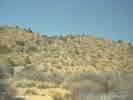 Vegetation along Wild Horse Canyon Road, in the head of Macedonia Canyon. Vegetation along Wild Horse Canyon Road, in the head of Macedonia Canyon.
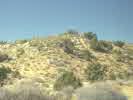 Vegetation along Wild Horse Canyon Road, in the head of Macedonia Canyon. Vegetation along Wild Horse Canyon Road, in the head of Macedonia Canyon.
|
Vegetation along Wild Horse Canyon Road, in the head of Macedonia Canyon. The large dark gray bushes in the foreground wash are Desert Almond (Prunus fasciculata), and the smaller yellowish bushes are Sticky Snakeweed (Gutierrezia microcephala). There are Utah Junipers (Juniperus osteosperma) and a few Singleleaf Pinyons (Pinus monophylla) on the slopes above the wash, but no Joshua Trees (Yucca brevifolia) are found at this location on the southeast slope of the Mid Hills. Difficult to see in the lower picture, but nevertheless still there, are numerous Blue Yucca (Yucca baccata) and Mohave Yucca (Y. schidigera) growing together. | ||||
|
Other articles:
Locations: Macedonia Canyon. |
Junction: Macedonia Canyon. | ||||
|
Other articles:
Locations:
Silver Buddy Mine.
|
Silver Buddy Mine | ||||
|
Other articles:
|
The first view south is dominated by Barber Mountain and Wild Horse Mesa. Lobo Point is also visible just below the rim of Wild Horse Mesa. | ||||
|
Other articles:
Locations:
Willow Well.
|
| ||||
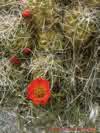 Mound Cactus (Echinocereus triglochidiatus). Mound Cactus (Echinocereus triglochidiatus).
|
Mound Cactus (Echinocereus triglochidiatus), sometimes also called Claret Cup Cactus, grows in the rocks in the canyons along Wild Horse Canyon Road. My impression is that the species is more common on the Precambrian schist and gneiss, but I have no data to support that conclusion. Occasionally the species can be found on alluvial soils. | ||||
|
Locations:
Columbia Mountain.
|
View looking north along Wild Horse Canyon Road. Columbia Mountain is in the center background. Willow Well is in the wash on the left (west) side of the road. The rocks here are Precambrian gneiss and schist. | ||||
|
Literature Cited:
Other articles:
|
This outcrop of tectonic breccia alongside Wild Horse Canyon Road contains Mid Hills adamellite with tumbled blocks of Precambrian gneiss (Reynolds and Reynolds, 1995). | ||||
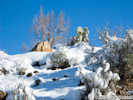 Snow on plants in Wild Horse Canyon Snow on plants in Wild Horse Canyon
|
Snow along the side of Wild Horse Canyon Road. | ||||
|
Other articles:
Locations:
Wild Horse Mesa.
|
Wild Horse MesaBelow are some of the plants found on the north face of Wild Horse Mesa. | ||||
|
Other articles:
|
North face of Wild Horse Mesa with snow on 19 December 2008. | ||||
|
Other articles:
|
The north slope of Wild Horse Mesa is just west of Wild Horse Canyon Road. This is the one of the locations of my study plots for Frasera albomarginata. Be sure to respect wilderness boundaries, as this road is a "cherry stem" into a wilderness area. Better yet, park your car on Wild Horse Canyon Road and walk. | ||||
|
Other articles:
Locations:
Wild Horse Mesa.
|
| ||||
|
Other articles:
|
Junction:
| ||||
| The north slope of Wild Horse Mesa is one of three places in the eastern Mojave where the informally named "Winkler Formation" crops out. The other two locations are Pinto Mountain and Hackberry Mountain. | |||||
|
Other articles:
Locations:
Wild Horse Canyon.
|
This photograph is looking south into Wild Horse Canyon after the Hackberry Complex Fire of June 22-25, 2005. While the flat in the foreground is completely burned, there are some very large unburned patches on the slopes of the mesa. | ||||
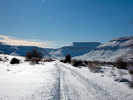 Snow in mid-Wild Horse Canyon Snow in mid-Wild Horse Canyon
|
Snow in the mid-Wild Horse Canyon, 19 December 2008. | ||||
|
Literature Cited:
Other articles:
Locations: Lobo Point. |
Lobo Point
| ||||
|
Locations:
Barber Mountain.
|
Sun setting on Barber Mountain. This view looks east, and Hole in the Wall is on the other side of the mountain. This mountain is not formally named "Barber Mountain," but the Barber VABM is located on top. The climb to the top is about 300 meters and takes about an hour. | ||||
|
Locations:
Lobo Point.
|
Sunset at Lobo Point after a rainstorm. This photo was taken in March, 1998, after a strong, warm El Niño rain. | ||||
|
Other articles:
|
I have seen some collections made in Wild Horse Canyon, that gave an ecological association of "Joshua tree woodland." However, I don't think I have ever seen Joshua trees in Wild Horse Canyon. I contacted the collector who was quite certain that there were Joshua trees in the area, but that they were not recovering well from the 2005 Hackberry Complex fire. So I went to the location of the collections, as given in geographic coordinates, and searched for Joshua trees. The location is shown in the photograph at left. I searched both sides of the road, across the wash and up on the benches on either side of the wash. I did not find Joshua trees. I did find burned stumps and sprouts of Banana Yucca (Yucca baccata) and Mohave Yucca (Y. schidigera), but not Joshua trees (Y. brevifolia). I'm not saying the Joshua trees aren't there. I'm just saying that I could not find them.
You might wonder, of course, what difference does it make? In my observation, Joshua trees occur on the northwest side of the Mid Hills ridge. They also are found on the ridge line. However, Joshua trees are not found on the southeast side of the Mid Hills ridge, until one reaches the higher elevations of Pinto Valley. I want to hypothesize that the Mid Hills ridge creates a small orographic precipation increase on the side from which winter storms come, the northwest side. The ridge also casts a small rain shadow on the lee side, the southeast side. The orographic effect and rain shadow are enough to affect Joshua tree distribution in this area. If there are Joshua trees in Wild Horse Canyon, then they provide a counter-example to my hypothesis. | ||||
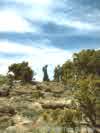 Wild Horse Mesa. Wild Horse Mesa.
|
A small group of hikers discuss the next destination, while standing on the north rim of Wild Horse Mesa. A few Utah Junipers (Juniperus osteosperma), a Blue Yucca (Yucca baccata), some small shrubs and some grasses grow in the rocky surface of the mesa. | ||||
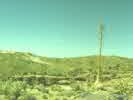 Century Plant (Agave desertii), western edge of Wild Horse Mesa. Century Plant (Agave desertii), western edge of Wild Horse Mesa.
|
Century Plant (Agave desertii) growing on the western edge of Wild Horse Mesa. This is about as far north as Agave desertii is found. There is a small colony here growing out of crevices in the rocks right on the edge of the mesa. In the right foreground is Buckhorn Cholla (Opuntia acanthocarpa). On the left is Blue Yucca (Yucca baccata). | ||||
 Barrel Cactus (Ferocactus cyindraceus). Barrel Cactus (Ferocactus cyindraceus).
|
This is me pretending to drape my arm across a California Barrel Cactus (Ferocactus cylindraceus) at the rock shelter on Wild Horse Mesa. Photograph taken in 1979. I don't look dorky like this anymore. | ||||
| The upper section of lower Wild Horse Canyon was completely burned by the Hackberry Complex Fire, June 22-25, 2005, except for some small patches on the other side of the wash and up near the rim of the mesa. | |||||
|
Other articles:
Locations:
Wild Horse Canyon.
|
The upper Wild Horse Canyon has several areas with well-developed pediments. This one burned completely in the Hackberry Complex Fire. | ||||
|
Other articles:
|
|||||
|
Other articles:
|
This rock shelter in Wild Horse Canyon is known as archeological site SBr-292. It has been pretty well studied so there are no artifacts to find, though. Unique to this site are the trees at low elevation in the canyon. There are Pinyons (Pinus monophylla) and Canyon Live Oaks (Quercus chrysolepis) growing in the northwest shade provided by outcrops of mud flow breccia. | ||||
|
Other articles:
Locations:
Wild Horse Canyon.
|
This rock outcrop is a well-known archeological site. The Hackberry Complex Fire of June 22-25, 2005, burned this rock outcrop, but was stopped by the wash and road. | ||||
|
Locations:
Wild Horse Canyon.
|
Wild Horse Canyon Road in the lower part of the canyon, view looking northwest, and up the canyon. At this location, Wild Horse Canyon Road drops off the bajada, and into the wash. A thicket of Mohave Yucca (Yucca schidigera) can be seen on the right side of the road. The road passes between the two outcrops of mud flow breccia (lahar) seen in the middle distance. The east side of Wild Horse Mesa is seen in the background. | ||||
|
Other articles:
Locations:
Wild Horse Canyon.
|
Patchy areas burned on the slopes of Wild Horse Mesa. | ||||
|
Other articles:
|
| ||||
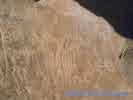 Petroglyphs inside the hollowed-out boulder. Petroglyphs inside the hollowed-out boulder.
|
 Petroglyphs inside the hollowed-out boulder. The petroglyph in the center has received a lot of attention by potential interpreters of petroglyphs. Petroglyphs inside the hollowed-out boulder. The petroglyph in the center has received a lot of attention by potential interpreters of petroglyphs.
| ||||
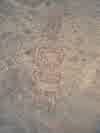 Pictograph at archeological site in Wild Horse Canyon. Pictograph at archeological site in Wild Horse Canyon.
|
Pictograph at the archeological site in Wild Horse Canyon. Pictographs are painted on the rocks with pigments, while petroglyphs are designed pecked into rocks. | ||||
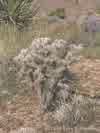 Silver cholla (Opuntia echinocarpa) in lower Wild Horse Canyon. Silver cholla (Opuntia echinocarpa) in lower Wild Horse Canyon.
|
Silver cholla (Opuntia echinocarpa) in lower Wild Horse Canyon. Silver cholla appears to be limited by elevation and isn't found at higher elevations. | ||||
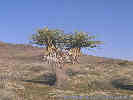 Mohave Yucca (Yucca schidigera) in lower Wild Horse Canyon. Mohave Yucca (Yucca schidigera) in lower Wild Horse Canyon.
|
Mohave Yucca (Yucca schidigera) in lower Wild Horse Canyon. | ||||
|
Literature Cited:
|
Miocene rhyolitic dome in lower Wild Horse Canyon. McCurry (1985) identified this structure as the oldest Miocene volcanic structure in the eastern Mojave. | ||||
 Musing about trails in Mojave National Preserve. Musing about trails in Mojave National Preserve.
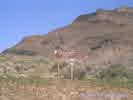 Wild Horse Canyon Trailhead Wild Horse Canyon Trailhead
|
At the south end of Wild Horse Canyon is a formal trailhead for a trail that goes north approximately 10 km to Mid Hills campground. The trail was always there, what has changed is the formal designation as a "trail." I guess we need trails since it's a national park. I just think there are some better places to mark and build trails. | ||||
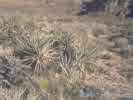 Blue Yucca (Yucca baccata) in lower Wild Horse Canyon. Blue Yucca (Yucca baccata) in lower Wild Horse Canyon.
|
Blue Yucca (Yucca baccata) in lower Wild Horse Canyon. | ||||
|
Other articles:
Locations:
Wild Horse Canyon.
|
The Hackberry Complex Fire came down this face of Wild Horse Mesa in the lower canyon, leaving patchy areas unburned. Photograph taken June 27, 2005 by Phil Woodall. | ||||
|
Other articles:
|
South side of Barber Mountain. | ||||
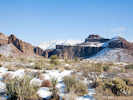 Woods Mountains behind Hole-in-the-Wall. Woods Mountains behind Hole-in-the-Wall.
|
After a snow storm, the Woods Mountains as seen through Hole-in-the-Wall. | ||||
| Some cattle water tanks and corrals in lowest Wild Horse Canyon. | |||||
|
Other articles:
|
Some petroglyphs near Banshee Canyon. If memory serves (doubtful 28 years later) there was a pictograph here or nearby. | ||||
|
Other articles:
Locations:
Hole-in-the-Wall.
|
| ||||
|
Other articles:
|
Junction: Black Canyon Road, north past Hole in the Wall and through Black Canyon, or south to Essex Road and a park exit. | ||||
| If you have a question or a comment you may write to me at: tomas@schweich.com I sometimes post interesting questions in my FAQ, but I never disclose your full name or address. |
Date and time this article was prepared: 5/12/2025 2:45:08 PM |